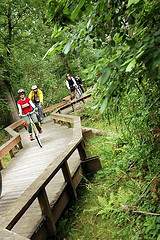A new report* estimates that our regional trail network saves us about $115 million per year in averted health care costs. The report (PDF) was done for Metro and focused on their interconnected system of trails, parks and greenways known as the Intertwine. The Intertwine (background story) consists of 1,250 miles of designated biking and walking trails, 12,000 acres of developed parks and 24,000 acres of maintained natural area and is visited by an estimated 8.3 million people each year.
In Physical Activity and the Intertwine: A Public Health Method of Reducing Obesity and Healthcare Costs, naturopathic doctor and public health expert Kurt Beil looked at the Intertwine as a public health asset. He analyzed the estimated amount of physical activity that occurs on the Intertwine and did some calculations to come up with health cost savings. Here’s an excerpt from his report:
“Subsequent estimates of obesity reduction, based on caloric expenditure, and resultant avoided healthcare costs were also conducted. These estimates are very rudimentary, but suggest that $155 million in healthcare costs may be averted annually as a result of the obesity prevention due to physical activity that occurs…”
Beil took the amount of usage the facilities receive, converted that into average calories burned, and then equated that with an estimated number of pounds lost by the physical activity on the Intertwine network.
“It is estimated that use of the Intertwine is responsible for the avoided weight gain of 17 million pounds/year among Metro region residents.”
Also as part of his analysis, Beil came up with an estimated number of annual trips made by bike across the entire Intertwine network — 81,025,291.
As advocates and agencies look to build the case for non-highway infrastructure investments, public health benefits of biking and walking are getting much more attention. Expect to see more Health Impact Assessments like this one for more transportation projects in the future.
Read the entire report via PDF here.
*Publisher’s note: The opening sentence of this story initially said a report “published.” I regret using that word because it is misleading. To my knowledge, the report has not been officially published anywhere.


